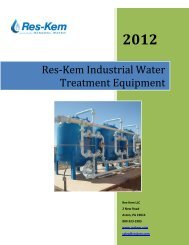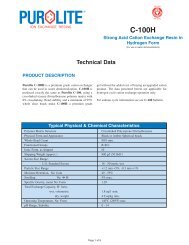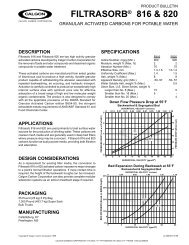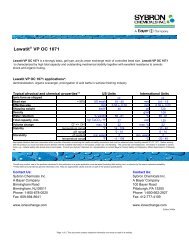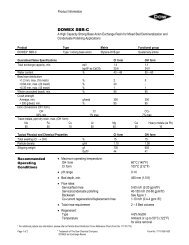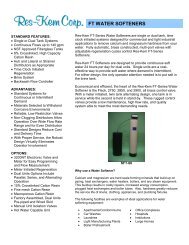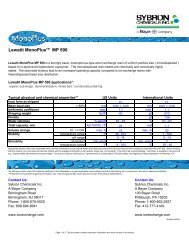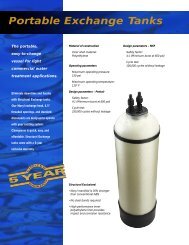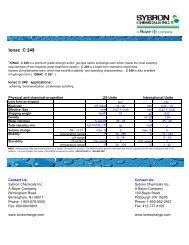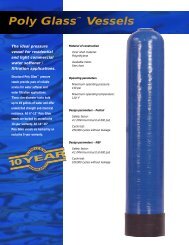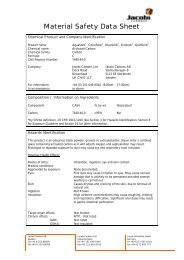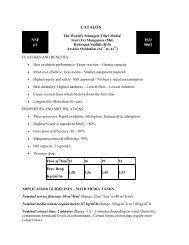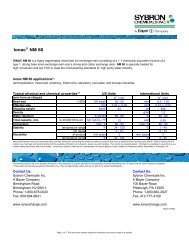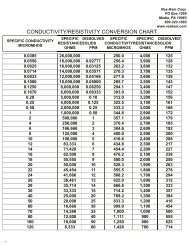Application Bulletin - Res-Kem Corporation
Application Bulletin - Res-Kem Corporation
Application Bulletin - Res-Kem Corporation
You also want an ePaper? Increase the reach of your titles
YUMPU automatically turns print PDFs into web optimized ePapers that Google loves.
Forms of Chloramine<br />
Table 1<br />
Activated Carbon Peroxide Numbers<br />
Table 2<br />
Species Chemical Water<br />
Formula Conditions Present<br />
Activated Carbon<br />
CAP* Number<br />
(MInutes)<br />
Monochloramine NH2Cl pH 7 - 9<br />
DiChloramine NHCl2 pH 4 - 4.6*<br />
TriChloramine NCl3 pH < 4.4**<br />
* Chloride / Nitrogen ratios between 5-to-1 and 7.6-to-1<br />
** Chloride / Nitrogen ratios excedding 7.6-to-1<br />
Catalytically Enhanced 8<br />
Bituminous Coal-Based<br />
Conventional Bituminous 40<br />
Coal-Based<br />
Subbituminous Coal-Based 40<br />
Lignite Coal-Based 80<br />
Wood-Based 120<br />
* Catalytic Activity Peroxide<br />
Monochloramine Removal<br />
Traditionally activated carbon has been used for chloramine removal. All activated carbons have some catalytic<br />
functionality and act as a catalyst to decompose monochloramine. The following two parallel reactions are believed to<br />
be the paths of decomposition:<br />
(1) NH 2 Cl + H 2 O + C* —> NH 3 + H + + Cl - + CO*<br />
(2) 2NH 2 Cl + CO* —> N 2 + 2H + + 2Cl - + H 2 O + C*<br />
In the decomposition of monochloramine, the first reaction predominates when the system begins operation. In doing<br />
so, the carbon surface (C*) reacts with monochloramine to reduce the monochloramine to ammonia and oxidize the<br />
carbon surface to form surface oxygen groups (CO*). It is these CO* groups that can mask the catalytic activity of an<br />
activated carbon. Fortunately, as the number of surface oxygen groups increases, the second reaction begins. If a<br />
sufficient number of original catalytic sites are not present, however, the second reaction does nto take place with<br />
enough frequency to regenerate the sites, leaving the carbon “spent.”<br />
Catalytically Enhanced Carbon<br />
Catalytic carbon is developed through an advanced process, starting as a bituminous coal-based granular activated<br />
carbon (GAC). By altering the electron structure, the GAC offers enhanced catalytic capability enabling it to cause<br />
chemical reactions to proceed without changing its own basic structure. With more catalytic sites available for electron<br />
transfer, it also promotes a wide range of chemical reactions where conventional carbons are not effective.<br />
To varying degrees, the existence of catalytic properties in activated carbon has been widely reported.² The<br />
fundamental significance of catalytic carbon is that its catalytic activity can not only be controlled, it can also be<br />
significantly enhanced during manufacturing - without the use of chemical impregnates. By modifying the electronic<br />
properties of the carbon surface, the manufacturing process results in 10-to-100 times greater catalytic functionality as<br />
compared to standard activated carbons.<br />
The catalytic activity of carbon can be measured by the rate at which a carbon decomposes hydrogen peroxide (H 2 O 2 ).<br />
Carbons with more catalytic sites show higher catalytic activity and decompose hydrogen peroxide at a faster rate.<br />
Table 2 compares the catalytic activity “Peroxide Number” for several types of activated carbon. The number given is<br />
the time in minutes required to decompose a fixed amount of peroxide. As shown in Table 2, catalytically enhanced<br />
bituminous coal-based carbon requires a fifth of the time of conventional bituminous coal-based carbons, 1/10th the<br />
time of lignite-based carbons and less than 1/15th the time of wood- and coconut-based carbons.<br />
Calgon Carbon <strong>Corporation</strong> Chemviron Carbon<br />
P.O. Box 717 Zoning Industriel C<br />
Pittsburgh, Pa 15230 B-7181 Feluy, Belgium



